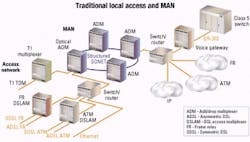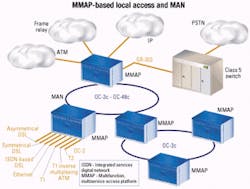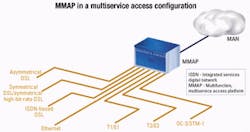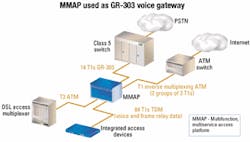Intelligence for the access edge
MMAPs, a new generation of equipment, integrate optical and access technologies, uniting the access network and the MAN.
CHARLES BAUMERT and JAN ERREYGERS, Terayon Communications Systems
Over the last 10 years, the capacity of optical equipment has grown tremendously. Optical transport has evolved from OC-3 (155 Mbits/sec) to OC-192 (10 Gbits/sec), and 40-Gbit/sec systems are now being demonstrated. DWDM today provides a means for multiplying transport capacity by factors ranging from 16 to 80 over one fiber.
Simultaneously, the telecommunications industry has generated a wide array of new access technologies, transport and network protocols, and services. Transmission control protocol/IP emerged as the dominant Layers 3 and 4 protocol for data networking, and ATM, frame relay, and point-to-point protocol became mature protocols in Layer 2. Prior to the 1990s T1/E1 (2 Mbits/sec) was the established high-speed access technology. Since that time, we have seen the advent of integrated services digital network (ISDN), ISDN-based DSL (IDSL), high-bit-rate DSL (HDSL), asymmetric DSL (ADSL), symmetric DSL (SDSL), symmetric high-bit-rate DSL (SHDSL), and inverse multiplexing ATM (IMA).
All of these technologies, protocols, and services were introduced to address particular telecommunication needs-and their use was obviously thought to be economically justified. This large variety of equipment, protocols, and services, however, presents a major challenge for new local-exchange carriers. To compete on a sufficiently large scale with an incumbent operator, they must offer a similar range of services. That requires a huge investment in diverse technology platforms, training of staff, and management of parallel networks and technologies. Typically, each service is transported over different optical channels, so a number of parallel networks are created at the optical layer.
Technical progress has continued, and there currently exists a new generation of equipment that integrates optical and access technologies in intelligent optical edge devices (OEDs), also known as multifunction, multiservice access platforms (MMAPs). The MMAP effectively unites the access network and the MAN.
It is immediately obvious that many types of equipment are in use today. Traditional TDM traffic for POTS, dial-up Internet service provider traffic, and frame relay are all carried over T1 lines. These T1 circuits are terminated in a T1 multiplexer that may or may not be connected to a crossconnect switch to perform a statistical multiplexing of active DS-0 (64-kbit/sec) circuits. Traffic is carried into the metro network via an optical add/drop multiplexer (ADM). The ADM only performs the function of multiplexing all of the different signals on the optical layer, and additional processing or statistical multiplexing are not performed.
The requirements for different types of equipment, as well as many different protocols, lead to substantial network complexity. Rack space is necessary to house the various types of equipment, and each piece of equipment usually comes with its own management system. Provisioning services requires coordinating the configuration of all involved network elements.
A new concept-one that strikes to the heart of the carrier's dilemma-is now emerging with the introduction of the MMAP approach. The MMAP concept combines, in a single platform, the functions of an optical multiplexer with a multiservice access device and adds the capability to support multiple additional functions, such as a GR-303/V5.2 gateway or T3/E3 (45-Mbit/sec) aggregation.
This new approach uses a rackmounted chassis that serves as a foundation for the MMAP platform. A wide variety of interface and function cards can be inserted into the MMAP chassis to tailor the platform to specific roles.There is already a trend underway to offer multiservice access platforms. Such devices integrate two or more access facility types into one device. What truly sets a MMAP platform apart is the high-density integration of all, or substantially all, of the access methods that a carrier may reasonably be expected to support. Those include incorporating additional functions into a single platform to effectively bridge the access network to the MAN. The MMAP can interface to any part of the MAN, or be located directly on the MAN, as appropriate.
Local carriers face a variety of challenges. At the top level, there is the ever-accelerating need to limit capital in vestment and improve profitability. Therefore, a number of issues are high on the priority list.
The financial markets have become much more reluctant to provide fresh capital to telecom operators. For a number of operators it is practically impossible to access new capital in the short term. Therefore, investment budgets are limited and money should be spent on projects that generate immediate revenue. Building a network with a service-specific approach requires high initial investment costs. For example, a complete DSL access multiplexer (DSLAM) chassis has to be installed and connected to the backbone before the first customer can be connected. This scenario is repeated for each new service.
An MMAP dramatically reduces upfront investment costs. Only one chassis is required to offer all available services, resulting in a much more modular network build-out. Line cards and modules are added when customers order service, thereby generating immediate revenue.Building out the MAN based on ATM-over-SONET results in significant savings of bandwidth. It has been shown that ATM-over-SONET in mixed voice-data applications reduces the required bandwidth in the MAN by a factor of two to four, depending on the application scenario. That allows the carrier to use lower speed optical equipment, such as OC-12c (599.04 Mbits/sec) instead of OC-48c (2.4 Gbits/sec), or OC-48c instead of OC-192. It is particularly the high-speed SONET equipment that is still very expensive.
Another important consideration is the limitation of rack space. For collocation applications, rack space is very limited and, therefore, expensive. When additional rack space is required, operating costs increase due to increased rent, energy charges, cooling charges, etc. The use of an MMAP platform significantly reduces rack space, and deployment is possible with one MMAP shelf to deliver all of the services. Only when one shelf is fully populated and revenue generating is a new shelf required.
Another driving force for MMAP platforms is the reduction of the operational complexity of managing disparate service-specific systems. MMAP platforms allow the management of the whole access and metro network through a single management system. The operational benefits include less staff training, unified alarm reporting, and a single, unified provisioning system.
MMAP platforms generally consist of a shelf with a multigigabit ATM and TDM backplane. Numerous plug-in cards are available for access and MAN connections. The ATM and TDM buses on the backplane interconnect the system's plug-in cards. Line cards connect to downstream devices (integrated access devices [IADs], DSLAMs, routers, private automatic branch exchanges, etc.) on the local access side of the MMAP. Each line card accepts data from one or more downstream devices and, if necessary, converts them from frame relay or TDM format to ATM cells. Those signals then travel over the ATM bus to the uplink cards and out to the MAN, or to other line cards and back to downstream devices. TDM-based traffic can also be crossconnected to other line cards over the TDM backplane bus, when no ATM features are required, reducing processing load and eliminating ATM cell packetization delays.Upon receiving ATM cell data from the line cards, the MAN card combines those signals into one ATM stream with multiple virtual paths and circuits. It then sends the data on those virtual circuits to the high-speed MAN. In the downstream direction, each MAN card retrieves the incoming data from the MAN. That data then travels over the ATM cell bus to appropriate line cards for distribution to the IADs, DSLAMs, and other devices. If necessary, the line cards also convert the incoming cells from the uplink cards to frame relay and/or TDM format before sending them to the downstream devices.
The MMAP is effectively a full ATM switch. By exploiting all the powerful quality of service features of ATM, each service achieves its guaranteed performance. That is the key to integration of different functions and services in one platform.
MMAPs can be used in numerous different applications. An MMAP provides a high-density platform for a full range of access facilities for voice and data. Interfaces include IDSL, ADSL, SDSL, SHDSL, HDSL, HDSL2, T1/E1, T3/E3, and 10/100Base-T Ethernet. Multiple protocols, such as TDM, frame relay, ATM, and IP, can be used. Typically, both traditional TDM voice and packet-based voice are supported.
A key feature of an MMAP platform is the inclusion of a GR-303/V5.2 voice gateway. Voice traffic enters the platform via TDM or ATM interfaces, while data can be transferred in a variety of ways, simultaneously. Voice-over-ATM traffic is converted to TDM, multiplexed together with native TDM voice traffic, and concentrated onto one or more T1 TDM, T3 TDM, or STS-1 TDM interfaces that connect via GR-303 interface (installed as a function card in the MMAP chassis) to a Class 5 switch. Partial or full GR-303 groups are supported and multiple GR-303 groups can be connected to the switch. Data is separately switched to the appropriate frame relay, ATM, or IP data network.An MMAP platform provides high input density capability that can be used to aggregate the outputs of multiple DSLAMs, ADMs, and other MMAPs into a single packet stream. The MMAP platforms accommodate a range of standards-based inputs including T3/E3 (TDM, ATM, or frame relay) and OC-3c/STM-1. If additional subscriber services are required at a site where an MMAP is being deployed as an aggregator, these services can be provided directly from the same platform. On the uplink, OC-3c/STM-1, OC-12c/STM-4 or OC-48c/STM-16 can be used to interface to the network in point-to-point or ring configuration. Some platforms also support T3/E3 ATM uplinks for low-capacity applications.
MMAP platforms provide versatile solutions for providing services to a variety of multitenant building or campus environments. A full range of access facilities for voice and data is available. Due to the highly scalable nature of MMAP platforms, the same equipment can be used as in the central office. Traditional TDM voice as well as packet-based voice is supported. Tenants' legacy needs are met, and the flexible, scalable platform can handle requirements for additional traditional or advanced services as required. For high-capacity applications, a fiber ring or fiber point-to-point connection can be installed in the building. Fiber-based IADs can be connected directly to the IMAP platform, offering customers unprecedented high-speed access.
In other applications, the connection with downstream devices will be made over copper using the appropriate range of access services. The modularity of the MMAP also allows for the mix and match of fiber-based and copper-based access in the same building. For smaller buildings, smaller versions of the MMAP platform are available. These smaller devices can reuse most of the plug-in cards of a full-size MMAP shelf. As the network-management system is exactly the same, configuration and provisioning of services are performed in a transparent way.
There are several benefits in the use of MMAPs, including multifunction, multiservice flexibility. The MMAP can be configured to support many different access network or MAN applications simply by selecting and provisioning the appropriate mix of uplink and line-cards. An extensive variety of functions can be supported, individually or concurrently, such as:
- Optical multiplexer.
- Multiservice access platform.
- GR-303/V5.2 gateway.
- T3/E3 aggregation.
- Multitenant application platform.
Scalability is enhanced, eliminating the need to "over-engineer" a point of presence (PoP), allowing headroom for future growth. Capacity can scale by installing additional line cards as demand for access ports increases. With its modular design, MMAP capacity can be matched to the required situation with much finer granularity, compared to equipment that has a fixed number of ports.
Should additional capacity for a single chassis become necessary, multiple chassis can be interconnected. Capacity can be added incrementally and more cost-effectively with a MMAP approach. Carriers can contemplate upgrades in the MAN without rendering large amounts of equipment obsolete-they can simply swap one optical uplink card in the MMAP for a higher speed interface.
Management is also simplified with MMAP. Instead of managing a number of different pieces of equipment from different vendors, each with its own management system, the MMAP, complete with all of its installed interfaces and functions, can be managed as one unit with a single management interface.
MMAPs are cost saving, since fewer pieces of equipment translate to lower cost for each PoP. Also, "forklift upgrades" are eliminated, since the MMAP can be reconfigured using board swapping if the mix of access types should change. Lower equipment costs and the avoidance of obsolescence results in a much faster return on a carrier's investment. MMAP greatly simplifies network architecture for the carrier, and since the carrier is able to provide multiple and diverse services, customers are more inclined to remain with the carrier.
One of the factors that allowed the Internet to grow at a phenomenal rate is the simplicity of its architecture. The Internet is essentially a mesh network of routers and interconnecting communications links. There is no hierarchy of devices-just one device, the router, is used everywhere. While higher-capacity routers are used at the core, they all perform one function-routing. Further more, only one basic protocol, IP, is used.
Carrier networks, however, do not enjoy the simplicity of the Internet. They tend to be hierarchically structured in contrast to the "flat" mesh structure of the Internet. At the access network, where things get particularly cluttered due in large part to the physical-layer constraints of twisted-pair phone wire and the legacy of a variety of protocols, carriers are forced to cope with multiple overlaid access networks. They must combine traffic from separate access networks onto some higher level network, such as the MAN. All of this creates enormous complexity for carriers and drives the need for equipment and space requirements-that is, unless some better way can be found.
The MMAP approach brings the simplicity inherent in the Internet to access networks. It also more tightly knits the carrier's optical MAN and access networks. With this approach, there is only one device, the MMAP, sitting at the interface between the MAN and handling all the required functions in the access network. Therefore, only one platform interfaces the MAN to the LAN and then through IADs to customers.
The dramatic reduction in complexity of the MMAP approach allows carriers to rationalize their networks. It lets them drive toward a world in which equipment requirements are reduced; network planning and expansion are simplified; logistical issues, such as sparing, are simplified; management becomes more uniform, comprehensive, and less compartmentalized; provisioning is simplified; and return-on-investment consequently soars.
Charles Baumert is vice president of marketing and product management and Jan Erreygers is technical marketing manager at Terayon Communications Systems (Santa Clara, CA). They can be reached via the company's Website, www.terayon.com.




